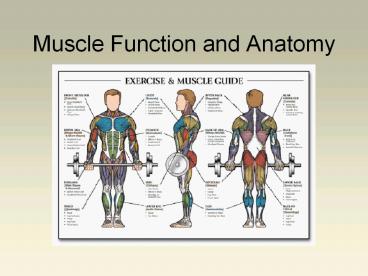Muscle Function and Anatomy - PowerPoint PPT Presentation
Title:
Muscle Function and Anatomy
Description:
Muscle Function and Anatomy Function of Muscle Motion of joints Movement of body fluids - pump blood, peristalsis Regulation of body fluids - bladder Body stability ... – PowerPoint PPT presentation
Number of Views:247
Avg rating:3.0/5.0
Title: Muscle Function and Anatomy
1
Muscle Function and Anatomy
2
Function of Muscle
- Motion of joints
- Movement of body fluids - pump blood, peristalsis
- Regulation of body fluids - bladder
- Body stability
- Heat production - 85
3
Muscle Architecture
4
How Are Muscles Built?
- In circular sections
- Deepest section contains two proteins
- Myosin
- Actin
- Myosin is surrounded by actin
5
Myofibrils
- Bundles of actin and myosin
6
(No Transcript)
7
Muscle Fiber
- Among others things, a muscle fiber contains many
groups of myofibrils
8
(No Transcript)
9
(No Transcript)
10
Fascicle
- A group of muscle fibers bundled together.
11
The Whole Muscle
12
The Whole Muscle
13
Muscle Membranes
14
Tendons
- All 3 membranes converge to form a tendon which
connects the muscle to the bone
15
Muscle Fiber Arrangement p. 25
- Pennate muscles
- Greater cross sectional area greater force
(strength) production - Parallel muscles
- Longer muscles greater range of motion
16
Muscle Fiber Arrangement
Strap
- Parallel muscles
- Flat (rectus abdominus)
- Fusiform (biceps)
- Strap (sartorius)
- Radiate (trapezius)
- Spincter
- Pennate
- Unipennate (biceps femoris)
- Bipennate (rectus femoris)
- Multipennate (deltoid)
17
Types of Muscle Contraction p. 28
- Isometric (Static)
- Isotonic (Dynamic)
- Concentric
- Eccentric
18
Types of Muscle Contraction
- Concentric contraction - If muscle force is
greater than the resistance - Static or Isometric contraction - If muscle force
is equal to the resistance - Eccentric contraction - If muscle force is less
than the resistance
19
Lengthens
Lengthens
20
Eccentric Contraction
- Used to control agonist and prevent over
lengthening of the antagonist. - Example triceps lowers dumbbell while biceps
controls the triceps activity (action). - Causes more damage than other types
- Greater repair required
- producing a stronger muscle
- Also, results in more muscle soreness.
21
TABLE 2.1 Type of Contraction Type of Contraction Type of Contraction
TABLE 2.1 Isometric Isotonic Isotonic
TABLE 2.1 Isometric Concentric Eccentric
Agonist muscle No change Shortening Lengthening
Antagonist No change Lengthening Shortening
Joint angle No change In direction of force In direction of external resistance
Direction of body part Against immovable object Against gravity or external force Consistent with gravity or external force
Motion Pressure but no motion Causes motion Causes motion
Description Static Dynamic shortening Dynamic lengthening
Muscle force v. Resistance F R F gt R F lt R
Speed Equal to resistance Faster than the inertia of the resistance Slower than the speed of gravity or applied inertial forces
Acceleration or Deceleration Zero A D
Symbol -
22
ROLE OF MUSCLES
- Agonist prime mover
- Antagonist have an action opposite to the
agonist - Stabilizers fixate or stabilize the joint
- Synergists assist or guiding
- Neutralizers counteract or neutralize movements
23
Agonist and Antagonist
24
Types of Muscle Fibers
- Fast twitch
- Slow twitch
25
Questions?































